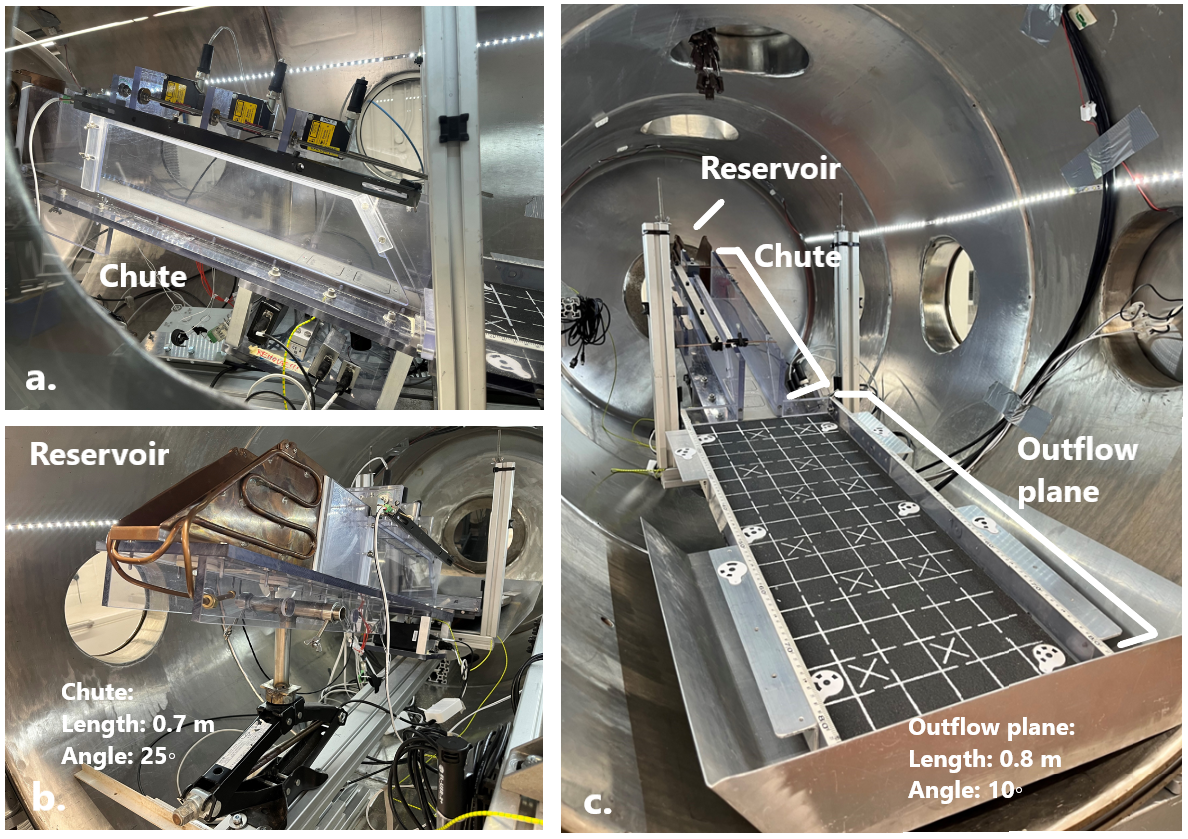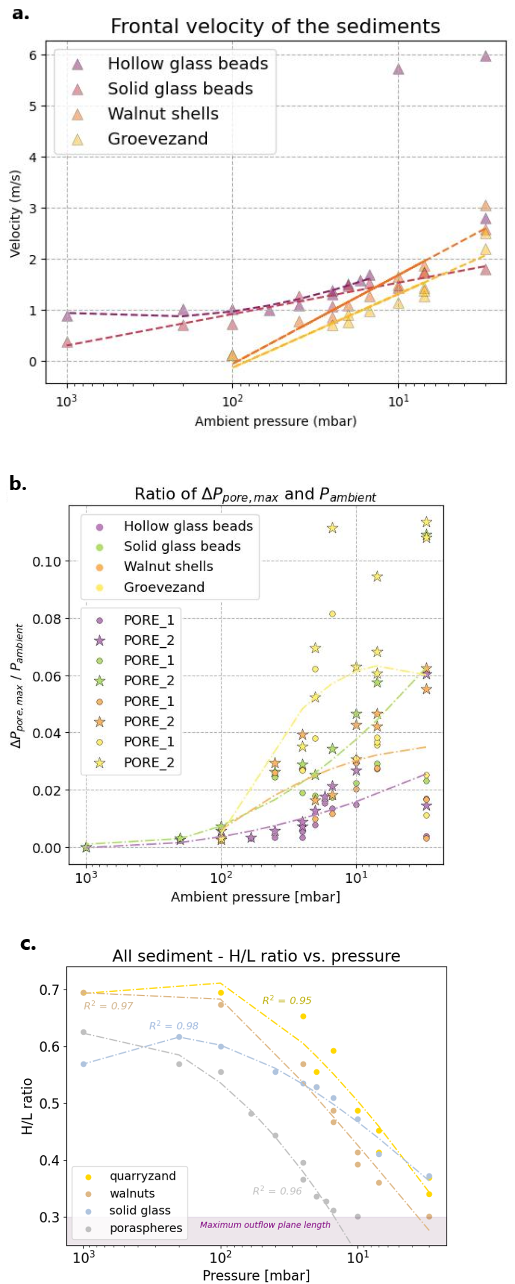- 1Utrecht University, Department of Physical Geography, Netherlands (s.j.m.diamant@uu.nl)
- 2School of Physical Sciences, The Open University, Milton Keynes, United Kingdom
- 3Laboratoire de Planétologie et Géosciences, LPG UMR 6112, 44000 Nantes, France
Introduction
Mass wasting is one of the most prevalent geomorphological processes contributing to surface evolution
across the Solar system [Moore et al. (1999); Roelofs et al. (2024)]. It is the downslope movement of
fine material (e.g., regolith) and granular material (e.g., rock debris) under the influence of gravity
seen in e.g., falls, slides, avalanches or flows. Identifying the
formative processes of mass-wasting can give us insights into the distribution of volatiles across the
Solar System which is important for future space missions [Parekh et al. (2021)]. Using terrestrial mass-wasting deposits as
analogues is useful with limitations [Scully et al. (2015)]. In contrast to Earth, on other planetary surfaces, water is at best metastable (i.e., boiling, sublimating and/or freezing).
While sublimation is a plausible surface process on some planetary bodies [Mangold (2011); Roelofs
et al. (2024)], it cannot be studied on Earth. Here we address this critical gap in our knowledge
of the mobility, morphology and evolution of sublimation-driven mass flows through laboratory-scale
experiments.
Sublimating ice causes gas to flow through granular material, reducing internal friction and enhancing the flow’s mobility. The velocity of the gas expansion depends on gas density and the material's permeability, regardless of gravity. However,
the force needed to lift the sediment particles with a given density is proportional to the gravitational
acceleration. Aspects of the effects of gravity on the morphology, mobility and dynamics of dry and
liquid-based mass-wasting have been studied (Kleinhans et al. (2011); Kokelaar et al. (2017)) but
remain poorly understood in sublimation-driven mass-wasting.
Here we study the role of gravity in sublimation-driven mass-wasting with
a set of experimental debris flows in a low-pressure chamber. We analyse the dynamics, morphology,
mobility, and fluidization of CO2-sublimation-driven mass granular flows under various atmospheric
pressures and sediments with varying densities.
Methods
The laboratory simulations were performed in a debris flow flume in a
cylindrical low-pressure Mars chamber of the Space and Planetary Environments Laboratory at the
Open University (Milton Keynes, UK). The debris flow is initiated from a sediment-ice reservoir atop a chute and runs out on an outflow plain (Figure 1). The downstream part of the chute is instrumented with two relative gas pressure
sensors to measure the overpressure (differential gas pressure,
i.e. gas flow pressure relative to the ambient pressure), a geophone to record seismic vibrations, a load cell to record the weight of the granular flow and three laser range sensors to capture the flow depth. Moreover, we used
a Phantom Miro C110 high-speed camera to capture the movement of the flow and the individual
particles.

Figure 1: The laboratory debris flow flume in the Mars chamber at the Space and Planetary Environments Laboratory at the Open University (UK). (a-b) display the chute including the instruments and the sediment-ice reservoir. (c) shows the entire flume looking upslope.
To represent atmospheric pressures on different planetary bodies, we applied a range of pressures
between 3 to 1000 mbar. The granular flows were simulated by mixing dry CO2 ice with granular materials to create sediment mixtures with different permeabilities and densities.
Two groups with angular sediments (quarry sand and walnut shells) and rounded sediments (solid and
hollow glass beads) were chosen so that we could also determine the effects of the sediments’ shape
on the granular flows. To assess the effect of lower gravity, each group has a higher-density sediment
used as reference (quarry sand of 2600 kg/m3 and solid glass beads of 2500 kg/m3
), and a lower-density sediment (crushed nutshell of 1300 kg/m3 and hollow glass beads of 410 kg/m3
). The particle distribution for the angular sediment was similar for all sediment mixtures and fixed to 25% fine (200 -
450 µm), 50% medium (450 - 800 µm) and 25% coarse (800 - 1300 µm). The rounded sediment had a
particle size range between 500 - 850 µm. Gravitational acceleration and density have the same effect
on the force needed to levitate the flowing sediment. Thus, to simulate low-gravity bodies, we utilize
low-density sediments.
Results and discussion
Our preliminary results reveal an overall increase in fluidization of the granular flows for decreasing
pressures. This is more prominent in the low-density sediments. At 3-10 mbar, we notice a
fluidization regime similar to bubbling, where the CO2 gas builds up in the flow and escapes following
a small outburst [Van Ommen et al. (2010)].

Figure 2: (a) frontal flow velocities, (b) overpressure: the ratio of the maximum
differential pore pressure (difference between basal and ambient pressure) vs. ambient pressure and
(c) runout: the H/L ratio of all the sediments.
The enhanced fluidization at low pressures is also apparent in the increased frontal flow velocities,
increased overpressure and increased runout length (H/L ratio, where H is 0.43 m and L is runout
length) (Figure 2). The internal pore pressure increases relative to ambient pressure (Figure 2b) which
decreases the internal particle friction and enhances the flow’s velocity (Figure 2c).
The levitation effect is observed here as increasing flow depth for decreasing pressures. This confirms the prior hypothesis that, at low ambient pressures, the gas outflux from sublimating CO2 ices increases, which levitates the sediment particles and reduces intergranular friction and particle
collisions [de Haas et al. (2019); Roelofs et al. (2024)].
Conclusion
Experiments have been performed to study the effects of gravity by mixing CO2 ice and granular
material with different permeabilities and densities. Low-density sediments, representing lower gravity,
display a longer deposit runout and higher frontal flow velocities and flow depths compared to high-density sediments. At low atmospheric pressures (3-10 mbar), we observe a transition in the
flow behaviour known as turbulent bubbling in the low-density sediments. These findings show that
atmospheric conditions and gravity on different planetary bodies lead to changes in the mobility and
flow behaviour of granular flows, which may be observable in the deposit dimensions. Further analyses
will focus on PIV data to study the appearance of bubbling at low pressures in more detail and elevation
models of the deposits from imagery to study their morphology.
How to cite: Diamant, S., Sylvest, M., Conway, S., Roelofs, L., Emerland, Z., Patel, M., Kleinhans, M., and de Haas, T.: Effects of gravity in CO2-sublimation driven granular flows in a simulated experimental environment, Europlanet Science Congress 2024, Berlin, Germany, 8–13 Sep 2024, EPSC2024-399, https://doi.org/10.5194/epsc2024-399, 2024.